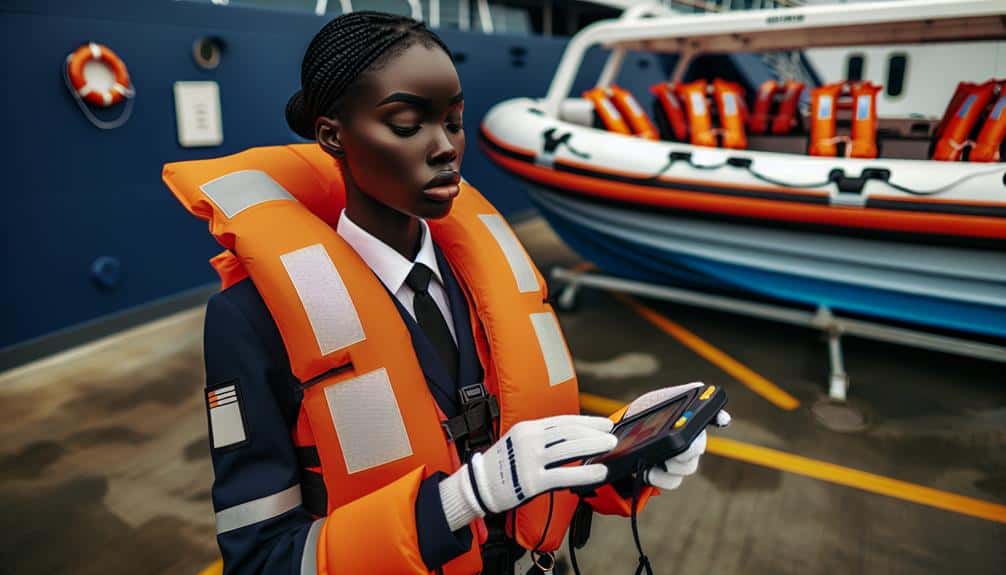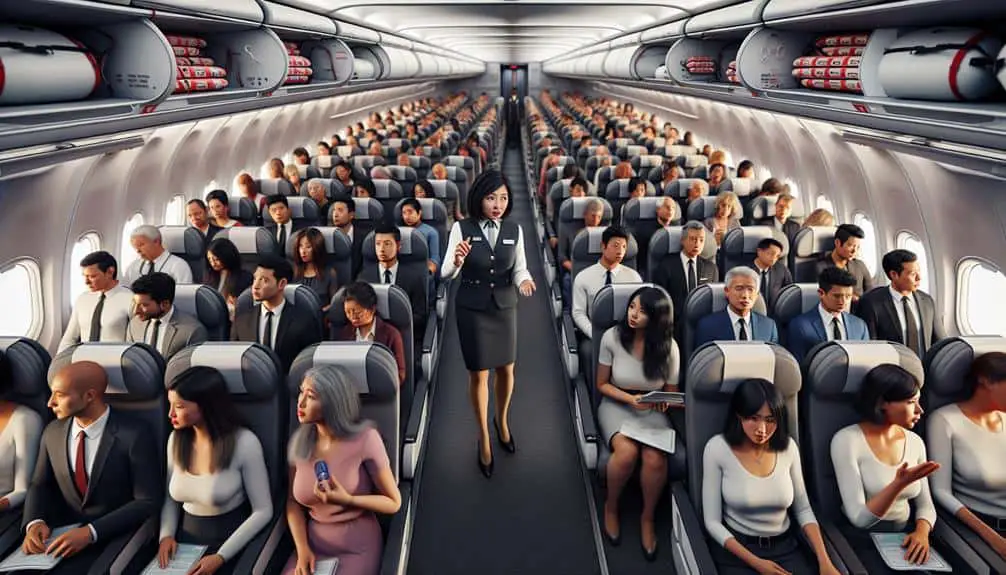Ensuring safety on a cruise ship requires rigorous staff training. It guarantees passenger and crew well-being. Compliance with regulations is crucial for ship operation. Training equips staff to handle emergencies like medical crises and fires. Preparation includes drills for effective response during crises. Crew communication enhances safety levels. Mitigate risks by enforcing strict safety protocols. By prioritizing safety, crew cohesion and response times improve. Want to know more about how safety training safeguards lives at sea?
Key Points
- Ensures crew can handle emergencies effectively.
- Compliance with regulations safeguards lives onboard.
- Enhances team coordination and response efficiency.
- Prioritizes passenger and crew safety through communication.
- Minimizes risks and liabilities with thorough training protocols.
Importance of Safety Training
To guarantee the well-being of both passengers and crew members, safety training is an essential requirement for all staff working on cruise ships. Safety procedures are the cornerstone of a successful cruise ship operation. Proper safety training guarantees that all crew members are well-equipped to handle emergency situations efficiently and effectively. This training covers a wide range of scenarios, from medical emergencies to fire drills and evacuation procedures.
Team communication plays a crucial role in maintaining a safe environment on board. Crew members must be able to communicate clearly and quickly with each other during emergencies to ensure a coordinated response. Safety training emphasizes the importance of effective communication channels and protocols to follow in different situations. By practicing communication strategies during training sessions, staff members can enhance their teamwork skills and be better prepared to handle any unforeseen events that may occur during a cruise.
Regulatory Compliance Requirements
Ensuring compliance with regulatory requirements is a vital aspect of maintaining safety standards on cruise ships. Compliance standards encompass a wide array of rules and regulations that govern various aspects of ship operations to guarantee the safety of passengers and crew. These standards cover everything from emergency procedures to sanitation protocols and fire safety measures. To meet compliance standards, cruise ship staff must undergo rigorous training on safety protocols to handle different emergency situations effectively.
Safety protocols are put in place to protect both passengers and crew in the event of an emergency. Staff members are trained to promptly respond to incidents, follow evacuation procedures, and utilize safety equipment correctly. Regular drills and exercises are conducted to make certain that everyone is well-prepared to handle emergencies. Compliance with these safety protocols isn't just a matter of following rules but an essential element in safeguarding the lives of those on board. By adhering to regulatory requirements and staying updated on safety protocols, cruise ship staff can create a secure environment for everyone on the ship.
Emergency Response Preparedness
Emergency response preparedness on cruise ships involves comprehensive training and regular drills to guarantee staff readiness in handling various emergency situations effectively. Emergency drills play a critical role in preparing cruise ship staff for scenarios such as fires, man overboard situations, medical emergencies, or even evacuations. During these drills, staff practice their roles and responsibilities, familiarize themselves with emergency equipment locations, and learn how to communicate effectively with passengers and other crew members.
Team coordination is essential during emergencies to guarantee a swift and organized response. Staff must work together seamlessly, following established protocols and communicating clearly to manage the situation efficiently. Regular practice through emergency drills helps improve team coordination, build confidence, and identify areas that may need improvement. It also allows for the evaluation of response times and the effectiveness of emergency procedures, enabling cruise ship staff to refine their skills and be better prepared for real-life emergencies.
Enhancing Passenger and Crew Safety
For a cruise ship to prioritize safety, implementing rigorous training programs and safety protocols is crucial. Crew communication plays a critical role in enhancing passenger and crew safety. Clear communication channels guarantee that everyone on board is informed and prepared in case of emergencies. Safety protocols must be consistently reinforced through training drills and regular updates to adapt to changing circumstances.
Effective crew communication involves not only transmitting information but also actively listening and confirming that the message is understood. Regular drills and simulations help to familiarize crew members with emergency procedures, enabling them to respond quickly and effectively when needed. Safety protocols are designed to provide a structured approach to handling various situations, from medical emergencies to evacuation procedures.
Mitigating Risks and Liability
To mitigate risks and liability on a cruise ship, it's essential to establish thorough safety protocols and provide detailed training for all staff members. Risk prevention is a key aspect of ensuring the safety of passengers and crew while also protecting the cruise line from potential legal issues. By implementing strict protocols for emergency situations, such as fires or man-overboard incidents, cruise ship staff can effectively respond to crises and minimize risks.
Training programs should cover a wide range of scenarios, from medical emergencies to severe weather conditions, equipping employees with the necessary skills to handle diverse challenges.
Legal protection is another critical element in mitigating risks and liability. Ensuring that staff members are well-versed in maritime regulations and safety standards can help cruise lines avoid costly lawsuits and damage to their reputation. By emphasizing compliance with industry regulations and internal policies, cruise ship operators can demonstrate a commitment to passenger and crew safety while safeguarding themselves against legal repercussions.
Regular reviews and updates to safety protocols are essential to staying ahead of potential risks and liabilities, ultimately creating a safer environment for everyone on board.
Frequently Asked Questions
How Often Do Cruise Ship Staff Receive Safety Training Updates or Refresher Courses?
In the vast ocean of knowledge, your safety is the compass. Cruise ship staff receive safety training updates or refresher courses regularly to guarantee retention, effectiveness, and engagement. Implementation and evaluation are key for continuous improvement.
Are There Any Specific Safety Protocols in Place for Staff Who Work in High-Risk Areas of the Ship?
In high-risk areas, specific safety protocols are crucial. Make sure staff training includes these protocols. Regular refresher courses are a necessity. Compare industry standards for best practices. Embrace technology innovations. Comply with regulations. Enhance communication methods for top-notch safety.
How Does Safety Training for Cruise Ship Staff Differ From Other Industries, Such as Aviation or Hospitality?
In the cruise ship industry, safety training for staff is specialized, focusing on ship-specific protocols and emergency procedures. Training methods emphasize hands-on simulations and scenario-based drills. Compared to aviation or hospitality, maritime safety standards prioritize crew readiness and teamwork effectiveness.
What Role Do Technology and Innovation Play in Enhancing Safety Training for Cruise Ship Staff?
Step into a world where virtual reality simulations transport you into safety scenarios, interactive modules engage your senses, wearable technology provides real-time feedback. Technology and innovation revolutionize safety training for cruise ship staff.
How Are New Safety Regulations and Best Practices Communicated to Cruise Ship Staff to Ensure Compliance?
To guarantee compliance with new safety regulations and best practices, cruise ship staff receive updated information through interactive simulations and virtual reality training. They also participate in onboard drills to practice emergency procedures effectively.




